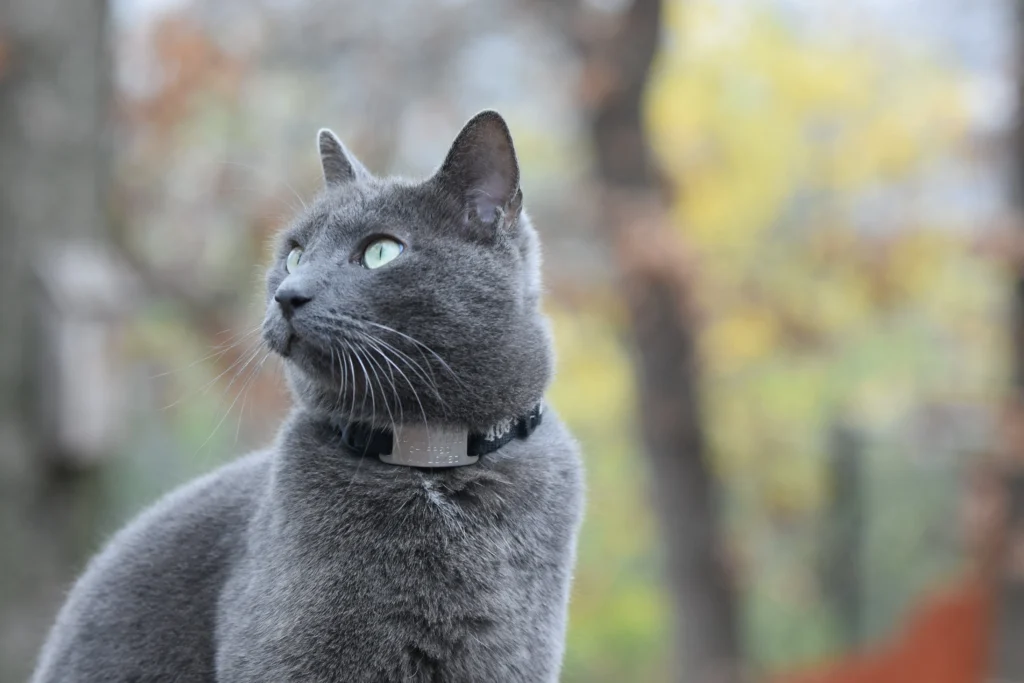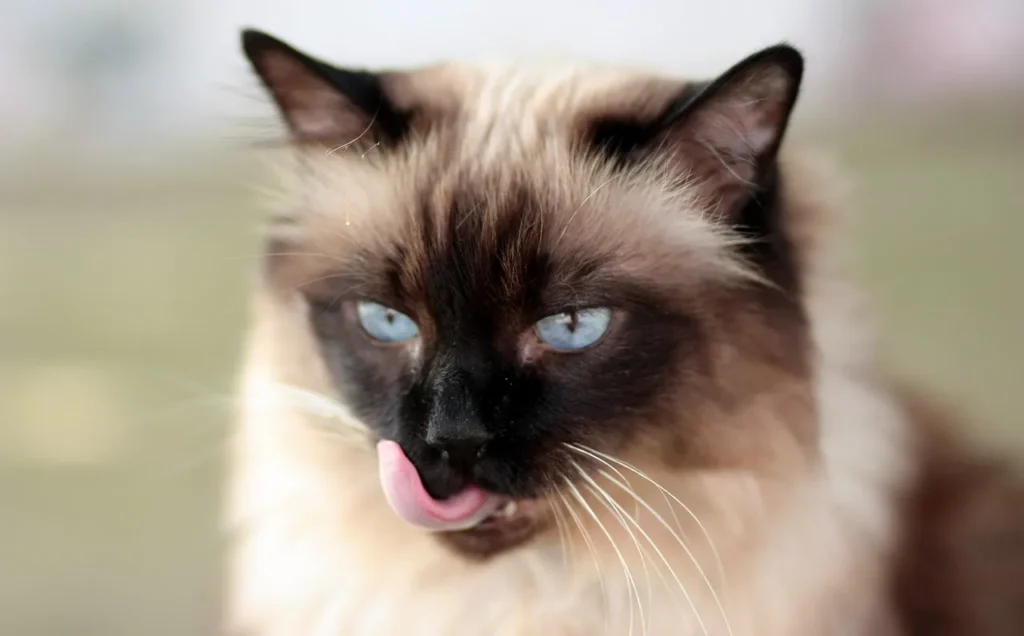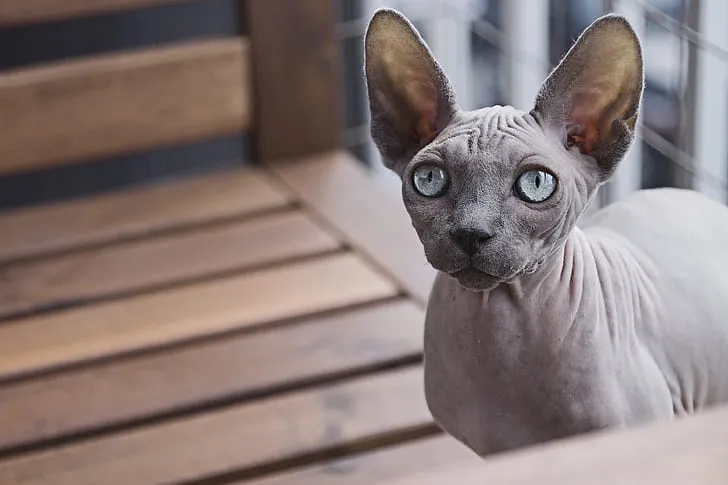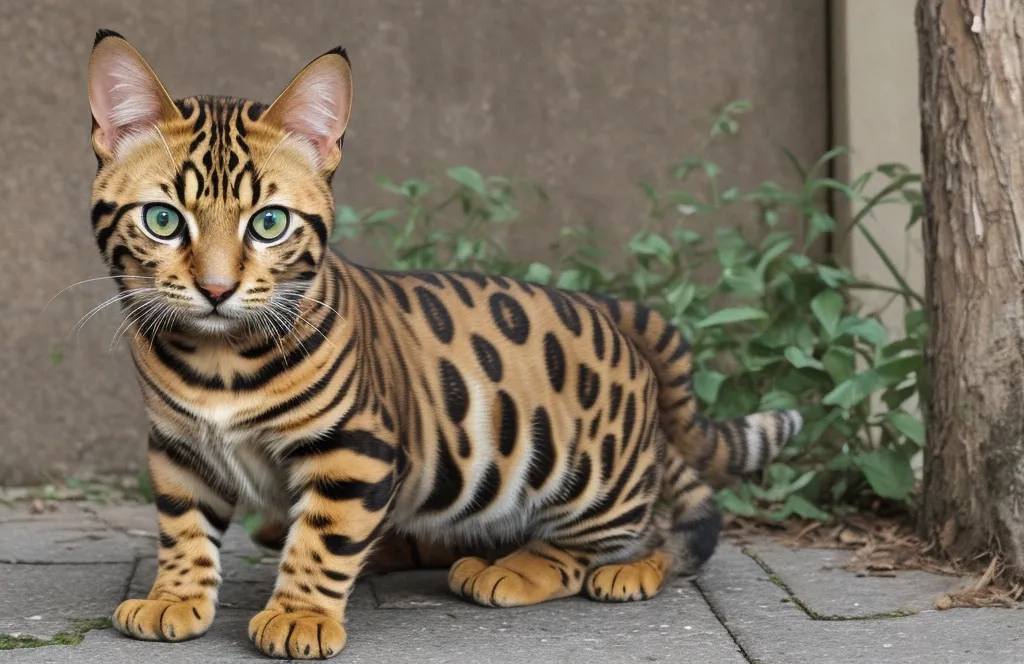Fear not if you’re an avid cat lover but struggle with allergies! Several hypoallergenic cat breeds might be the perfect furry companions for you. This comprehensive guide will explore the 4 Hypoallergenic Cat Breeds for people with allergies. Let’s dive into the world of feline friends that won’t leave you sneezing.
Brief Overview of Hypoallergenic Cat Breeds
Some cat breeds make fewer allergens, so they suit people with cat allergies. Knowing about these breeds is essential to have a happy home with our cat buddies.
Importance of Hypoallergenic Breeds for Allergic Individuals
If you love cats but have allergies, hypoallergenic cats can let you enjoy having a furry friend without getting allergies. These unique cat breeds don’t just make you a pet owner; they also help improve the well-being of people with allergies.
Russian Blue

Unique Features of Russian Blue Cats
Russian Blue cats are special because they have a regal attitude and a unique look. They stand out as one of the most enchanting and hypoallergenic cat breeds.
1. Silver-Blue Coats
The hallmark feature of Russian Blues is their stunning silver-blue coats. The short, dense fur gives them an elegant sheen, making them a visually striking presence in any home.
2. Captivating Green Eyes
One cannot help but be captivated by the mesmerizing green eyes of Russian Blue cats. Their eyes, set against the backdrop of their silver-blue fur, create an alluring and unforgettable gaze.
3. Graceful Physique
Russian Blues possess a graceful and slender physique. Their lithe bodies, combined with a fine-boned structure, contribute to their overall elegance and poise.
4. Quiet and Gentle Demeanor
Russian Blues are gentle and calm and known for their pleasing looks. They make delightful companions. Their quiet demeanor adds a touch of sophistication to their charm.
Why Russian Blues Are Considered the Best Hypoallergenic Cat Breeds
Let’s discuss why Russian Blue cats are great for people with allergies. Special qualities make them a top choice for those prone to allergies.
1. Low Fel d 1 Protein Production
Russian Blues are known for producing lower levels of the Fel d 1 protein, a common allergen found in cat saliva and skin glands. This reduction in allergen levels significantly decreases the likelihood of triggering allergic reactions.
2. Minimal Shedding
Russian Blues don’t shed much, unlike some other breeds. Their short fur stops allergens from spreading, making them good for people sensitive to cat dander.
3. Fastidious Grooming Habits
Russian Blue cats keep themselves very clean by grooming often. This helps reduce allergens on their fur, making the environment more hygienic and hypoallergenic.
Tips for Caring for a Russian Blue
Russian Blues are easy to take care of. Take good care of them to keep your cat healthy and happy.
1. Regular Brushing
Even though they have short fur, regular brushing helps to remove loose hairs and reduce shedding. This keeps your Russian Blue looking sleek and minimizes the potential for allergen buildup.
2. Quality Nutrition
Give your Russian Blue a good and healthy diet. High-quality cat food makes them healthy and keeps their coat nice, reducing the chance of skin-related allergens.
3. Interactive Play
Play with your Russian Blue. It makes them happy and content and strengthens the bond between you and your cat.
4. Regular Veterinary Check-ups
Routine veterinary check-ups are crucial for monitoring the health of your Russian Blue. Early detection of health issues allows for prompt intervention, ensuring your beloved pet’s long and healthy life.
5. Allergen Management
While Russian Blues are hypoallergenic, it’s essential to manage allergens effectively. Regularly dust and vacuum your house to keep it tidy. This helps make a hypoallergenic space for both you and your cat.
To summarize, Russian Blue cats are pretty and great for cat lovers with allergies. If you learn about their unique features and how they’re good for allergies and take good care of them, you can have a happy and fun friendship with your Russian Blue cat.
The Balinese Cats

Physical Traits of Balinese Cats
Balinese cats are known for being graceful and elegant. They are in the same family as Siamese cats. Let’s see what makes Balinese cats unique and adds to their hypoallergenic appeal.
1. Sleek and Svelte Body
Balinese cats have sleek and strong bodies that show their athleticism. Their long, slender frame makes them look elegant and visually stunning.
2. Almond-Shaped Blue Eyes
The almond-shaped, vivid blue eyes of Balinese cats are captivating. Their deep blue gaze is known to express intelligence and curiosity, adding to the charm of these feline companions.
3. Long, Fine Coat
Balinese cats have a long, fine coat. Their fur feels silky and makes them look regal. They don’t have an undercoat, which adds to their hypoallergenic qualities.
4. Color-Point Markings
Similar to Siamese cats, Balinese cats exhibit color-point markings. Their darker fur is concentrated on the ears, face, paws, and tail, contrasting with the lighter body color.
Allergen Levels in Balinese Cat Fur
Learn about allergen levels in Balinese cat fur if you’re considering this breed with allergies. Find out what makes Balinese cats hypoallergenic.
1. Low Fel d 1 Protein Production
Like Siamese cats, Balinese cats make less of the Fel d 1 protein, a primary allergen in cat saliva and skin glands. This helps lower allergen levels, reducing the chance of causing allergies in sensitive people.
2. Minimal Shedding
The Balinese cat’s fine fur doesn’t shed much. These cats produce low Fel d 1, which reduces allergens in the air. They are, therefore, an excellent option for those who have allergies.
3. Frequent Grooming Habits
Balinese cats clean themselves a lot. Their grooming keeps their fur clean and makes the environment hypoallergenic by reducing allergens.
Why Balinese Cats Are Considered Hypoallergenic
Find out why Balinese cats are great for people with allergies. They mix beauty with hypoallergenic qualities.
1. Combination of Beauty and Hypoallergenic Qualities
Balinese cats are special with beauty and hypoallergenic traits. They look elegant, have low allergen levels, and don’t shed much. They are great for cat lovers who want both aesthetics and fewer allergens.
2. Reduced Allergen Transfer
Balinese cats clean themselves and have fine fur, so they don’t spread many allergens. This improves homes for people with allergies, helping cats and owners live happily together.
3. Suitable for Individuals with Mild Allergies
Balinese cats are often well-tolerated by individuals with mild cat allergies sufferers. Their hypoallergenic traits let people with sensitivities enjoy having a cat without harming their health.
Tips for Caring for a Balinese Cat
Ensuring the well-being and happiness of your Balinese cat involves specific care practices. Explore essential tips for providing the best care for your hypoallergenic feline companion.
1. Regular Grooming
While Balinese cats groom themselves frequently, supplement their efforts with regular grooming sessions. Brushing their fine coat helps prevent matting and reduces loose hairs, creating a cleaner living environment.
2. Nutritious Diet
Feed your Balinese cat a balanced diet. Good food helps keep them healthy, with a nice coat and skin, lowering the chance of allergen-related problems.
3. Interactive Play
Balinese cats love to play and be social. Play with them to make them happy and to strengthen your bond with your cat.
4. Allergen Management in the Home
Add allergen management to your home routine. Clean regularly by vacuuming and dusting to reduce allergens. This makes a healthier environment for you and your Balinese cat.
5. Regular Veterinary Check-ups
Make sure to schedule check-ups for your Balinese cat with the vet. Checking early helps find health problems quickly and ensures your pet has a long and happy life.
To sum up, Balinese cats are both elegant and hypoallergenic. Learn about their traits, allergen levels, and care needs to enjoy their companionship in a hypoallergenic home.
Sphynx: Unveiling the Mystique of Hairlessness

The Hairless Nature of Sphynx Cats
Sphynx cats look unique because they have no cat hair. They show how different and diverse cats can be. Let’s explore the unique characteristics that define the intriguing world of Sphynx cats.
1. Bare Elegance
The Sphynx cat’s hairless coat reveals a velvety, soft, warm skin. Despite the absence of fur, their skin exhibits various colors and patterns, adding to their charm and uniqueness.
2. Muscular Build
Sphynx cats have a well-defined and muscular physique. Their lack of fur accentuates the visibility of their muscles, creating a striking and powerful presence.
3. Large Ears and Prominent Eyes
Large ears and expressive, prominent eyes characterize the facial features of Sphynx cats. Their alert, inquisitive gaze and oversized ears contribute to their captivating and endearing appearance.
Myth Debunking: Sphynx Cats and Allergies
Contrary to popular belief, Sphynx cats challenge conventional notions about hypoallergenics. Let’s dispel common myths surrounding their potential to induce allergies.
1. Myth: Hairless Means Allergen-Free
While Sphynx cats lack the typical fur that harbors allergens, the cat breed produce skin oils and proteins that can trigger allergies. The misconception that hairlessness equals hypoallergenic is a myth we aim to debunk.
2. Understanding Allergen Sources
Sphynx cats may have lower levels of the Fel d 1 protein in their saliva and skin glands, but it’s essential to acknowledge that other factors can still trigger allergies. Proper understanding is key to managing expectations.
Why Sphynx Cats Are Considered Hypoallergenic
Despite their hairless nature, delve into why Sphynx cats are a potential hypoallergenic choice.
1. Reduced Shedding
Without a fur coat, Sphynx cats shed minimal hair. This reduction in shedding decreases the dispersal of allergens, making them a favorable option for individuals with sensitivities to cat dander.
2. Limited Fur-Related Allergens
Sphynx cats aren’t entirely allergen-free, but their lack of fur reduces some allergens. They might be a good choice for people looking for a cat with fewer allergy challenges.
3. Skin Care Routine
Sphynx cats require regular bathing to manage the oil buildup on their skin. This grooming routine keeps them clean and minimizes potential allergen sources, contributing to a more hypoallergenic environment.
Tips for Caring for Sphynx Cats
Owning a hairless cat comes with distinctive care requirements. Explore essential tips to ensure the health and happiness of your Sphynx feline companion.
1. Regular Bathing
Frequent bathing helps control the accumulation of oils on the skin. Use a gentle cat-friendly shampoo and follow a consistent bathing schedule to maintain your Sphynx cat’s cleanliness.
2. Protecting from Sun Exposure
Sphynx cats lack fur to protect them from the sun. Take precautions by limiting their exposure to direct sunlight, especially during peak hours, and consider pet-friendly sunscreen for outdoor adventures.
3. Maintaining a Warm Environment
Sphynx cats are more susceptible to temperature changes because they don’t have fur. Keep your home comfortably warm and provide cozy spots for your cat, such as heated beds or blankets.
4. Regular Vet Check-ups
Routine veterinary check-ups are crucial for monitoring the health of Sphynx cats. Special attention to their skin health ensures early detection and management of potential skin-related issues.
Special Considerations for Sphynx Cat Owners
Owning a hairless cat introduces unique considerations. Uncover the special care routines and factors to remember as a Sphynx cat owner.
1. Clothing for Protection
Sphynx cats may benefit from wearing clothing, especially in cooler environments. Pet-friendly clothing options protect them from temperature variations and reduce direct contact with the skin.
2. Sunscreen Application
Consider applying pet-friendly sunscreen to your Sphynx cat’s exposed skin for outdoor activities. This precaution protects them from sunburn, ensuring their well-being during outdoor adventures.
3. Understanding Skin Health
Regularly monitor your Sphynx cat’s skin health. Look for any signs of irritation, dryness, or excessive oiliness. Understanding their unique skin needs allows you to provide targeted care for optimal well-being.
In conclusion, the mystique of Sphynx cats extends beyond their hairless exterior. By dispelling myths, understanding their hypoallergenic qualities, and embracing unique care routines, Sphynx cat owners can revel in the distinctive charm and companionship of these extraordinary felines.
Bengal Cat: The Best Hypoallergenic Breed

They stand out as the best hypoallergenic breed, combining stunning characteristics with low-allergen qualities:
Why Bengal Cats Are Considered Hypoallergenic
Bengal cats are considered hypoallergenic due to their:
- Distinctive Coat: The reduced shedding of their luxurious coat minimizes allergen dispersal.
- Low Fel d 1 Production: Bengals produce lower levels of the Fel d 1 protein, making them a suitable choice for allergy-prone individuals.
- Playful Nature: Their active and playful demeanor doesn’t exacerbate allergies, offering a joyous companionship without the sneezes.
Tips for Caring for Bengal Cats
Ensuring the well-being of your Bengal cat involves specific care practices:
- Regular Playtime: Engage in interactive play sessions to satisfy their active instincts, promoting physical and mental health.
- Proper Grooming: Brush your Bengal cat’s coat regularly to minimize shedding and reduce the presence of allergens.
- Balanced Diet: Provide a well-balanced, high-quality diet to support their overall health and minimize potential allergen-related issues.
- Allergen Management: Implement measures to minimize allergen levels in your home, including regular cleaning and using air purifiers.
Special Considerations for Bengal Cat Owners
Owning a Bengal cat comes with unique considerations:
- Interactive Environment: Create an enriching environment with toys and activities to stimulate your Bengal mentally.
- Allergen Testing: Individuals with severe allergies should consider allergen testing before bringing a Bengal into their home.
- Regular Veterinary Check-ups: Schedule routine vet check-ups to monitor your Bengal’s health and address any potential issues promptly.
In conclusion, Bengal cats are captivated with their beauty and offer a hypoallergenic solution for cat lovers. By understanding their characteristics, following care tips, and considering special considerations, you can enjoy the company of a Bengal without compromising on health or allergies.
Tips for people who are Allergic to Cat
General Advice for Managing Allergies with Cats
Cat ownership for allergic individuals requires specific considerations. Gain insights into general advice for managing allergies while enjoying the company of a feline friend.
Creating a Hypoallergenic Living Environment
Beyond choosing a hypoallergenic breed, creating a hypoallergenic living environment is crucial. Learn practical tips for minimizing allergens in your home.
Regular Grooming and Cleaning Routines
Regular grooming and cleaning routines are essential for keeping allergen levels at bay. Discover effective practices to maintain a clean and allergy-friendly home.
Choosing the Right Hypoallergenic Cat Breed for People
Factors to Consider When Selecting Hypoallergenic Cat breeds
Choosing the right hypoallergenic cat involves considering various factors. Explore key considerations to ensure a harmonious match between owner and feline companion.
Consultation with Breeders or Shelters
Whether purchasing from a breeder or adopting from a shelter, consultation is crucial. Understand the importance of communication with breeders or shelter staff to make an informed decision.
Understanding Individual Allergy Sensitivities
Individuals vary in their allergy sensitivities. Learn how understanding your specific allergies can guide you in selecting the most suitable hypoallergenic cat breed.
Benefits of Having Hypoallergenic Cat Breeds
Emotional and Physical Health Advantages
The benefits of having a hypoallergenic cat extend beyond allergy relief. Explore the emotional and physical health advantages that come with these feline companions.
Allergy Relief and Improved Well-being
For individuals with allergies, hypoallergenic cats offer significant relief. Understand how these cats contribute to improved well-being and overall health.
Companionship and Reduced Stress Levels
The companionship of a cat is known to reduce stress levels. Discover how hypoallergenic cats provide companionship and a calming influence on their owners.
Reducing Cat Allergens in your home: Quick Tips
Living comfortably with a cat, even with allergies, is possible. Here are quick tips to minimize cat allergens in your home:
- Regular Grooming: Brush your cat often to reduce loose fur and dander.
- Allergen-Reducing Wipes: Use cat wipes designed to reduce allergens on your cat’s fur.
- HEPA Air Purifiers: Invest in purifiers to filter out airborne allergens, including cat dander.
- Allergen-Proof Bedding: Cover pillows and mattresses with allergen-proof cases.
- Frequent Vacuuming: Use a HEPA filter vacuum cleaner regularly.
- Hard Flooring: Opt for hardwood or tile floors over carpets.
- Minimize Fabric Upholstery: Choose furniture with leather or microfiber upholstery.
- Designated Pet-Free Zones: Establish areas where your cat is not allowed.
- Air Circulation: Ensure good ventilation with open windows and fans.
- Regular Cleaning: Dust and clean surfaces frequently.
Implementing these quick steps can create a more allergy-friendly home for both you and your feline companion.
Common Myths About Hypoallergenic Cats
Dispelling Misconceptions About Hypoallergenic Cat Breeds
Hypoallergenic cats are not exempt from misconceptions. We’ll address common myths to understand these unique feline breeds better.
Clarifying the Role of Cat Saliva and Dander
Misunderstandings about cat saliva and dander contribute to misconceptions. Gain insights into the actual role these elements play in allergies.
Realistic Expectations for Allergic Individuals
Setting realistic expectations is vital for individuals considering hypoallergenic cats. Learn what to expect and how to navigate the challenges of owning these breeds.
Conclusion
Learn about what makes each hypoallergenic cat special. Understand why they’re good for people with allergies. If you have allergies, consider getting one of these cats for a happy friendship. Having a hypoallergenic cat can be great because it’s good for your health, and you enjoy sharing life with a loving cat friend.
FAQs
Q. What Makes a Cat Hypoallergenic?
Learn about why some cats are hypoallergenic and how they differ from those that aren’t.
Q. Are Hypoallergenic Cats Suitable for Families with Children?
Check if hypoallergenic cats are good for families with kids. Think about what families need and how they work together.
Q. How do you introduce a hypoallergenic cat to a new home?
Discover how to bring a hypoallergenic cat into a new home smoothly. Make sure both the cat and its new owner have an easy transition.
Q. Can Hypoallergenic Cats Still Trigger Allergies?
Talk about whether hypoallergenic cats can still cause cat allergies. Learn how to handle possible allergic reactions.
Q. Where Can I Find Reputable Breeders for Hypoallergenic Cats?
Look for good breeders or shelters that have hypoallergenic cats. Make sure you find a reliable place to get your new cat friend.


